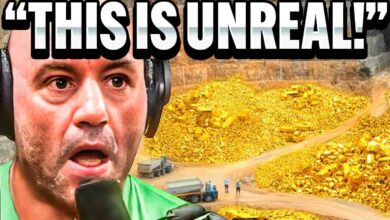The Curse of Oak Island: “Peculiar” Lead Token Uncovered from Lot 5 (Season 10)
The Curse of Oak Island: "Peculiar" Lead Token Uncovered from Lot 5 (Season 10)

Back on lot five, oh yeah,
Jack Begley has joined metal detection expert Gary Drayton at lot 5 on the western side of the island.
“Let’s find everything we can, all right mate? You ready to dig some history up?”
“Always.”
“Okay mate.”
This year, after purchasing lot five, Rick, Marty, and the team quickly made some of the most historic finds in the history of the Oak Island Treasure Hunt.
These include a stone structure that may date back to the same era as the garden shaft,
tools that may be more than four centuries old,
and half of a Roman coin that has been dated to as early as 300 BC.
“Bit of a choppy signal, but…”
“I think it’s beyond question that the acquisition of lot 5 was a wise thing for the fellowship. Gary’s finding artifact after artifact, but has already, during the short period we’ve owned it, produced definitely some of the oldest finds on Oak Island.”
“It’s a big old square nail.”
“Yeah, this one would be maybe late 1700s.”
Lot 5 could maybe fill in a piece of the puzzle as to where the people were who built the Money Pit.
“Maybe they were on lot 5. Those dots have certainly not been connected yet. That’s why we need to keep looking.”
“All right, next target. We ain’t got to go very far for.”
“Thanks.”
[Music]
“So yeah, just dig it all mate.”
“You’re a beast mate.”
“It’s still in there.”
“Try and find it.”
“It’s in my end.”
“Oh.”
It’s a lead on lot 5 on the western side of Oak Island. Gary Drayton and Jack Begley have just unearthed a potentially important artifact.
“Well, it’s so ornate for lead.”
“Yeah, it’s got a scalloped edge. That is really, really unusual mate. Can I see it?”
“That is unusual.”
“It’s nice and heavy, isn’t it?”
“Yeah.”
“Why would anyone make something like that?”
“Now, it could be like a token made. That is nice. I mean, I’ve found tokens that go all the way back to Roman days. They’ve actually found Roman tokens, and we have found a Roman coin right here on lot 5 behind us.”
A possible lead token found on lot 5.
Originating more than 2,000 years ago in ancient Rome, trade tokens were coin-like objects made with various kinds of metal and even non-metallic materials that were issued by private entities rather than official governments to be used in place of sanctioned currency.
Although many cultures have issued their own forms of trade tokens throughout history,
now we’re adding to the lead database because this is special. Could Gary Drayton be correct that this believed trade token is related to the Roman coin found on lot 5 earlier this year?
But if so, who brought them to Oak Island?
“Whenever we find lead mate, I get excited because sometimes you get some pretty amazing results, and I like the rare unique finds because they tell us more information. I say we take this back to the lab and get the archaeologists checking this out and working on it.”
“I agree.”
“All right mate, this could be a very important artifact.”
Following their discovery on lot 5, with another find, smiles were on the table.
“Yeah, wait till you see this.”
Gary and Jack meet with Rick Lagina, Craig Tester, and archaeologist Laird Niven in the interpretive center.
“Okay, let’s see it.”
“Yeah, this is a nice piece of lead.”
“We’ve never seen it before. Oily decorated scallops around the edges.”
“Well, it looks like there’s two holes punched through.”
“Seems to be two holes, and it’s brittle too.”
“Yeah, it’s an old piece.”
“Fancy design here, but nothing seemingly on the face, right?”
“Yeah, and you’re certain that’s intentional, the scalloping?”
“Yeah, definitely intentional. Would have been molded right. It poured into molds, I would expect.”
“My math, that’s what we thought. Maybe it could be a token.”
“About why put all that fancy design around it, you know?”
“That bear’s looking into for sure. And I know it’s made of lead mate, but can we do any scans on it?”
“Yeah, so we can clean it gently, see if there’s anything we can bring out on it, and then I would think…”
“XRF.”
After Laird cleans the artifact in order to determine its composition,
“Can I take a look?”
He will perform an extensive 24-hour scan of it using the team’s x-ray fluorescence device.
By emitting non-destructive radiation, the XRF machine can identify the elements that are present in the object.
“This object has the potential to be quite revealing. It’s singularly unique. We’ve not seen this item before, but we need to continue to persevere and try to understand what this is.”
“I mean, we don’t think it’s a button. It’s got holes in it, but they’re not centered.”
“Gary was thinking gold coin, wasn’t he?”
“We thought token.”
“I’m just wondering if it’s really old, crowded away… has got more information.”
Okay, what we are understanding so…
Now that Emma has completed an extended x-ray fluorescent scan of the mysterious lead disc that was found two days ago on lot 5,
she is prepared to share her preliminary analysis on the object’s content and potential geographic origin.
“What’s up? The machine speak?”
“Emma, hello!”
“What have we got?”
“So, you’ll see two different tones. There’s a white layer and a dark layer.”
“Oh.”
“So I did two long point scans on each of those layers, and what came out was that the light layer is about 99.96 lead, pretty pure, with a 0.02 copper and iron.”
“The dark layer does have some iron content, about 0.41, and about 0.4 percent copper and 0.2 percent silicon, but both those leads are naturally occurring leads like you can order them.”
“So that one is of interest because you don’t see something like that. It gained my curiosity even further, so I did an XRD scan afterwards.”
“The initial mineral that I found that it matched to is a sample found in the mines of Iran. But when it matches a sample, it doesn’t necessarily mean it comes from that exact mine, but anything that lies on the same geological belt, which goes across Italy, near France, Spain.”
“So there is a sample off the coast of Italy, and it’s matching those results. So this comes from somewhere in that region. It doesn’t occur in North America.”
“What about age? Shed any light on that?”
“It’s hard to date this lid. It’s really pure, so it can be old, but the fact that I am getting a hit from Sardinia, which, you know, there are Roman mines there… Is it possible that the lead artifact discovered on lot 5 could have originated in Italy?”
“If so, could it be related to the Roman coin that was found earlier this year and also support the belief of researchers such as Xena Halpern and Emiliano Saketti that members of the Knights Templar were connected to the Oak Island mystery?”
“The fact that this type of ore stretches across southern Europe… it’s the trail of the Templars. Could this artifact be associated with that?”
“It could, but there’s a lot of work to do yet before you make that statement, but it is on the trail of the Templars.”
“So once again, we have an unknown item coming from places it shouldn’t come from.”
“How’s that?”
“Yeah.”
“Based on where it was found, we think it’s very old. Appearance and shape might mean something to somebody, so we get it out there. Somebody’s going to know what that is.”
“I would think so. There’s no question about it. I’m keenly interested in this. It has scalloped edges, and it has a peculiar shape, and it has peculiar holes in the center of it. So our hope is that it might be rather significant.”
“Okay, so we dig the heck out of lot five. Agreed?”
“So look, I’ll follow up on all this, and as soon as any data at all comes in, I’ll let everybody know.”
“Okay, let’s get that done. Emma, thank you very much.”
“Thank you, Emma. Stay on it.”
[Foreign]
[Foreign]
[Foreign]








